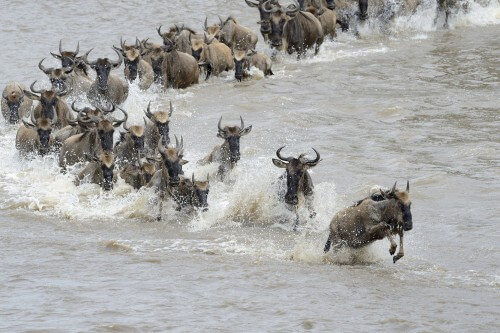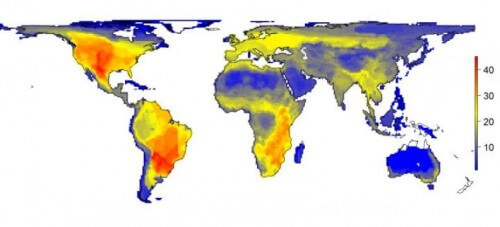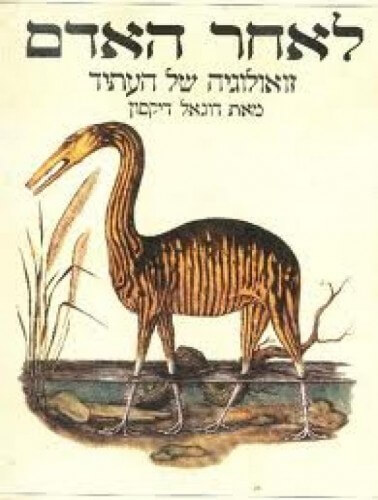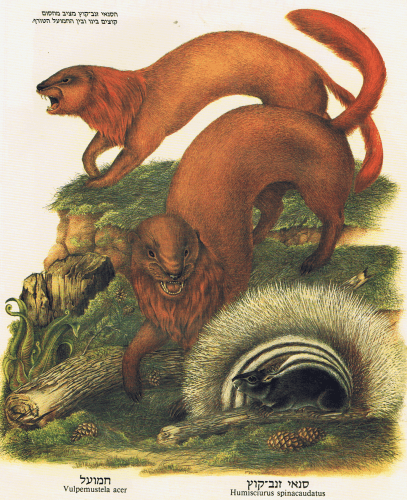Researchers from Denmark estimate that in Northern Europe not only moose and wolves could roam, but also elephants, lions and tigers and many places in the world would look like the Serengeti. Africa has the greatest diversity of large mammals simply because of its underdevelopment, the researchers say
Avi Blizovsky and Dr. Assaf Rosenthal

"Without people, most of the north of Europe would be inhabited not only by moose, bears and wolves, but also by elephants, rhinoceroses and even lions and tigers." This is according to researchers who examined the biodiversity of the large mammals around the world and built a map depicting their estimated distribution without human development.
In a study published on August 21 in the journal Science, Prof. Jens Christian Svenning (from Aarhus University in Denmark) writes, "Without people, the whole world would look like the Serengeti." He adds that "the reason why the greatest variety of large mammals is found in Africa is because (sub ) human activity "and not because of climatic or environmental reasons"
The researchers showed that the extinction of the large mammals at the end of the last ice age occurred mainly because of the expansion of the human presence in the entire world. Later, the researchers checked what the distribution of the largest mammal species in the world would have been without the extreme influence of the human population, according to today's species distribution patterns and while adjusting to the natural environment and biogeography.
For example, today there is a greater variety of species in mountainous areas. Until today, the scientists treated this as a result of the difference in the environmental conditions between the mountains and the valleys that caused the difference between the animals in the two adjacent environments, but according to the map it turns out that the environmental factor is a secondary factor for the difference in distribution. The main reason for the difference is that the mountainous environment provides shelter from human activities that harm the environment, such as hunting or farming.

As an example, the researchers cite the brown bear that lives today only in mountainous areas in Europe after it was exterminated in all accessible and dense areas. The map they created illustrates how poor today are areas that were rich in animal diversity in the not too distant past, especially Europe and North America.
When you check the nature tourism map, you can see that most of the safari trips are directed to Africa, since Africa is the last refuge where there is still a large variety of mammals due to little human activity that has not yet imitated the large mammals (still, because the hunters continue their activities, despite all the attempts to stop them) .
One of the reasons for Africa's underdevelopment is the fact that the human population on the continent is under constant pressure from pests and diseases that prevented a population explosion. Since man originated in Africa, the same pressure enabled the evolutionary adaptation of animals to an environment where there is a sparse human presence.
A better understanding will help preserve nature
The data series from which the distribution maps of each of the large mammals were built will be available to all researchers who wish to analyze the natural patterns of species distribution and the combination of species all over the world. Therefore, it will be able to provide a better understanding of natural factors that determine the biological diversity in a specific area.
The researchers say the study may serve as an important baseline for any restoration and conservation project.

This study is somewhat reminiscent of a book full of illustrations called "After Man" - Zoology of the Future by Dougal Dixon (translation by Dr. Naomi Carmel, Sefrit Ma'ariv Publishing House, 1984). In the introduction to the book, the zoologist and author Desmond Morris writes: "Instead of inventing a parallel evolution that takes place as if in another world, Dixon took upon himself the fascinating task of predicting future evolution on our planet, based on the actual species that exist today."
Dixon jumps forward in time 50 million years, and he predicts what life will look like in all climate zones and major ecological niches, based on today's animals, which have undergone an impressive evolution, but this is after he excludes from the process the animals that are dominant today, including humans. In the process, readers are also educated in understanding evolution - genetics, natural selection, the way animal forms developed, convergent evolution, the food chain, and more. Based on the current background, he sails forward and estimates which animals will roam the world which is similar but different (mainly due to continental drift).
The most interesting and important part of the book are the many illustrations depicting animals living in a specific environmental niche. For example, he hypothesizes that the predators will not be the descendants of today's predators - the lion, the tiger, the bear, but rather the offspring of the rodents - in the temperate regions, as well as of animals that are now herbivores.

Abstract of the scientific article
For an article on Eurekalert
More of the topic in Hayadan:

17 תגובות
There are places where it is already realistic:
http://www.ynet.co.il/articles/0,7340,L-4707283,00.html
It is known that humans are destroying the earth.
All the drugs and technology do help and even extend our lives, but it is a fact that there is a hole in the ozone. I always thought humans were just destroying the earth.
I also always dreamed of living in an ecological village. From what I understand, there is no such village in the country. Wrong
If the living have a chance to survive it is only thanks to us.
If a meteor comes, or something else that wants to destroy us, we are their only hope.
Following Assaf and Eitan's comments, I agree that natural is a semantic matter, but your main argument that I disagree with is that the change that our industrial society causes to the environment will eventually harm us despite the great benefit it brings us as a pen and in the last two hundred years in general, and this is because we have no mechanisms to stop us from destroying ourselves Along with the environment, your claim is wrong because we have such mechanisms and they are the economic mechanisms that were discovered by a branch of science and research that is not mentioned at all on this site quite puzzlingly and this is of course the branch of economics that investigates how the economic mechanisms distribute the resources that are being reduced that have alternative uses in the most efficient way to reduce the the lack and scarcity and increase human well-being, the environment is one of the most important resources together if technological knowledge and capital properly managed by these mechanisms increases the material well-being of humanity in the last centuries but the environment unlike the other two is much less tradable which makes it difficult for the mechanisms of the market to act on it The governments would do well and privatize every piece of land, water and air, including all the animals that live on them so that they can be traded, or then the mechanisms of the market economy will work on them and divide them in a way that increases the welfare of humans in the most maximal way, a piece of the environment that is good for man will remain, while one that is harmful will disappear, the environment And the individual should be separated, the individual should absorb the "natural" environment and turn it into another part of the market system that increases his well-being.
the censored
And those who lead this tactic with them are the spearhead of the left.
The delusional of the left (as opposed to the right) are at the forefront. And are considered the leaders of the left... if their leaders are like that, just think what a herd is trailing after them... (actually why guess, just look at the reactions of the leftists here).
Leftist tactics have been known since the days of Stalin, all those who oppose them will be defined as crazy or enemies of the revolution
Dear Idan:
Man was a part of nature until the early stone age,
Starting about 50,000 years ago, man "separated" from nature...
In another place I wrote that:
One of the main problems of the human race is technological development
which predates the "cultural instincts" by tens of thousands of years,
A state where instincts and culture are unable to exert inhibitions
which previously prevented negative activities...
Also regarding the reaction of "the censor"
It has already been said that:
Ignorance is not a flag worth waving...
Idan
First of all, natural is a rather semantic matter. A sick person will not care if the disease was caused by a "natural" poison or an industrial effluent. He will be interested in the cure for his disease.
To say that all human actions are "natural" is as meaningless as to say that all human actions are "human".
The definition does not matter, what matters is that the human race has the ability to plan and think for the future and has been using it for tens of thousands of years in order to adapt the environment to itself.
There are other companies that do this, but we do it on an infinitely large scale and thus, change the environment for better or for worse.
Organisms that produce oxygen as a byproduct of photosynthesis caused a mass extinction more than 2 billion years ago in an event known as the "Oxygen Holocaust". They acted "naturally" and caused the extinction of many species (including themselves). The increase in the concentration of oxygen in the atmosphere was great for large multicellular organisms (including humans) but, if they had a conference, they would probably end it with a call to act to reduce the emission of oxygen into the atmosphere and find "natural" means of producing energy.
The debate about whether what we do is natural or not is quite redundant.
Bottom line, our actions change the environment we are used to and over time, our actions can affect our ability to exist in a new environment we create.
The "naturalness" of the actions has nothing to do with the consequences of the actions.
The only thing that comes from treating human actions as natural is taking the responsibility away from people who don't want it.
The main problem with this article and the whole "theory" behind it is the thinking that man is not part of nature, that our influences, our industrial society and our technology are unnatural, which I think is clearly illogical. Man is part of nature and all his actions are natural.
Doron asked a legitimate question and accepted my opinion on the matter.
Censored is a troll who enters a scientific website in order to complain about the "leftists".
Instead of entering into an imaginary political discussion, it is better to ignore it. Turns out it can work.
What a clever attempt by the censored sage to treat the political left, a crime that has nothing to do with the left, by using a word that absolutely characterizes the right and only the right that really strives to eliminate Zionism by promoting the agenda of Hamas (terrorists in the sage's language ), that is, one country between the Jordan and our becoming a minority in the sea of terrorists (again, according to the sage).
pathetic
To all the stupid commenters
Messiah, I mean an imaginary utopia. Like all the delusional and utopian leftist ideas and ideologies. Indeed, for example communism as well as peace with terrorists etc...
Messianic faith, whether referring to Christ the son of David, Jesus the son of David, the Mahdi or any belief in the chosen one who will come, according to the prophecy, and save the world from evil, encourages abdication of responsibility, faith in a powerful figure that will take from the believers the burden of making decisions and responsibility for their actions and it is Basically a retreat to a childish state where a parent figure protects and decides for the believer.
Left Messiah is a combination of words that I have not yet heard. Maybe it means blind faith in the sun of nations?
I don't understand why Messianic is a dirty word.
Right,
The left is messianic and not the right which really expects the Messiah and the rest of the right.
The level of commenters here lately is amazing
The dream of the delusional left, this is the reason for the anarchy that the messianic left is creating in the world.